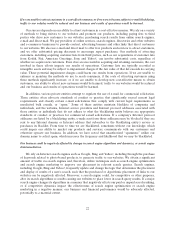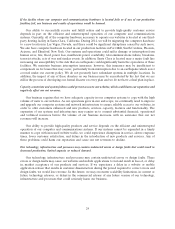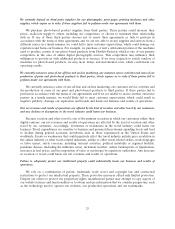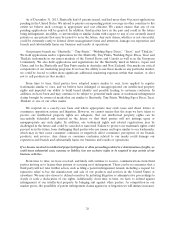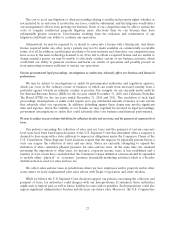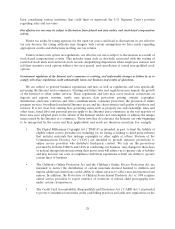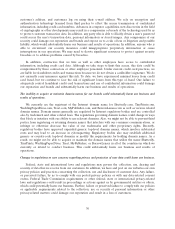Shutterfly 2013 Annual Report Download - page 22
Download and view the complete annual report
Please find page 22 of the 2013 Shutterfly annual report below. You can navigate through the pages in the report by either clicking on the pages listed below, or by using the keyword search tool below to find specific information within the annual report.which would damage our reputation and brands and substantially harm our business and results of
operations.
If we are unable to adequately control the costs associated with operating our business, our results of operations will
suffer.
The primary costs in operating our business are related to producing and shipping products, acquiring
customers, compensating our personnel, acquiring equipment and technology and leasing facilities. If we
are unable to keep these costs aligned with the level of revenues that we generate, our results of operations
would be harmed. Controlling our business costs is challenging because many of the factors that impact
these costs are beyond our control. For example, the costs to produce prints, such as the costs of
photographic print paper, could increase due to a shortage of silver or an increase in worldwide energy
prices. In addition, we may become subject to increased costs by the third-party shippers that deliver our
products to our customers, and we may be unable to pass along any increases in shipping costs to our
customers. The costs of online advertising and keyword search could also increase significantly due to
increased competition, which would increase our customer acquisition costs.
We may undertake acquisitions to expand our business, which may pose risks to our business and dilute the
ownership of our existing stockholders.
A key component of our business strategy includes strengthening our competitive position and refining
the customer experience on our websites and mobile applications through internal development. However,
from time to time, we may selectively pursue acquisitions of complementary businesses, such as our 2013
acquisition of BorrowLenses LLC, R&R Images, Inc. and MyPublisher, Inc. and our 2012 acquisitions of
ThisLife, Inc., Penguin Digital, Inc. and Photoccino, Ltd. and certain assets of Eastman Kodak Company.
The identification of suitable acquisition candidates can be time-consuming and expensive, and we may not
be able to successfully complete identified acquisitions. Furthermore, even if we successfully complete an
acquisition, we may not achieve the anticipated benefits we expect due to a number of factors including the
loss of management focus on and the diversion of resources from existing businesses; difficulty retaining
key personnel of the acquired company; cultural challenges associated with integrating employees from an
acquired company into our organization; difficulty integrating acquired technologies into our existing
systems; entry into a business or market with which we have historically had little experience; difficulty
integrating data systems; the need to implement or remediate the controls, procedures or policies of the
acquired company; and increased risk of litigation. For example, in March 2013, we filed a complaint for
damages and injunctive relief, alleging that Eastman Kodak failed to comply with the non-compete
provisions of the transfer agreement that it had entered into with us in April 2012. And in October 2013,
we acquired BorrowLenses LLC, an online photography and video equipment rental business, which is a
new business model for us to integrate and may present different challenges. Failure to achieve the
anticipated benefits of such acquisitions or the incurrence of debt, contingent liabilities, amortization
expenses, or write-offs of goodwill in connection with such acquisitions could harm our operating results.
In addition, we may issue equity securities to complete an acquisition, which would dilute our existing
shareholders’ ownership, perhaps significantly depending on the terms of such acquisitions and could
adversely affect the price of our common stock. For example, in connection with our 2011 acquisition of
Tiny Prints, we issued approximately 5.4 million shares of our common stock as transaction consideration.
To finance any future acquisitions, it may also be necessary for us to raise additional funds through public
or private debt and equity financings. Additional funds may not be available on terms that are favorable to
us, and, in the case of equity financings, would result in dilution to our stockholders. Also, the value of our
stock may be insufficient to attract acquisition candidates.
20














